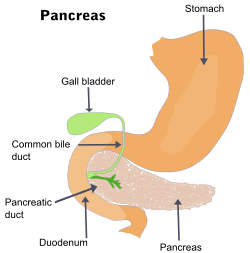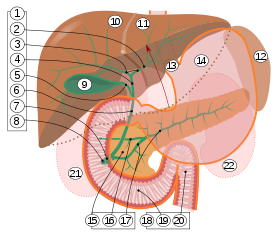Thepancreatic ductorduct of Wirsung(also, themajor pancreatic ductdue to the existence of an accessory pancreatic duct) is a duct joining thepancreasto thecommon bile duct.This supplies it withpancreatic juicefrom theexocrine pancreas,which aids indigestion.
| Pancreatic duct | |
|---|---|
 The pancreatic duct | |
 | |
| Details | |
| Precursor | Pancreatic bud |
| Identifiers | |
| Latin | ductus pancreaticus |
| MeSH | D010183 |
| TA98 | A05.9.01.015 |
| TA2 | 3129 |
| FMA | 10419 |
| Anatomical terminology | |

2.Intrahepatic bile ducts
3.Left and right hepatic ducts
4.Common hepatic duct
5.Cystic duct
6.Common bile duct
7.Ampulla of Vater
8.Major duodenal papilla
9.Gallbladder
10–11.Rightandleftlobes ofliver
12.Spleen
13.Esophagus
14.Stomach
15.Pancreas:
16.Accessory pancreatic duct
17.Pancreatic duct
18.Small intestine:
19.Duodenum
20.Jejunum
21–22. Right and leftkidneys
The front border of the liver has been lifted up (brown arrow).[1]
Structure
editThe pancreatic duct joins thecommon bile ductjust prior to theampulla of Vater,after which both ducts perforate the medial side of the second portion of theduodenumat themajor duodenal papilla.There are many anatomical variants reported, but these are quite rare.[2]
Accessory pancreatic duct
editMost people have just one pancreatic duct. However, some have an additionalaccessory pancreatic duct,also called theDuct of Santorini.An accessory pancreatic duct can be functional or non-functional.[3][4]It may open separately into the second part of the duodenum,[3][4]which is dorsal, and usually (in 70% of people) drains into theduodenumvia theminor duodenal papilla.In the other 30% of people, it drains into the main pancreatic duct, which drains into the duodenum via the major duodenal papilla. The main pancreatic duct and the accessory duct both eventually—either directly or indirectly—connect to the second part ('D2', the vertical segment) of theduodenum.
It is named forGiovanni Domenico Santorini.[5][6]
-
Formation of an accessory pancreatic duct
Clinical significance
editCompression, obstruction or inflammation of the pancreatic duct may lead toacute pancreatitis.The most common cause for obstruction is the presence ofgallstonesin thecommon bile duct,a condition calledcholedocholithiasis.Obstruction can also be due to duodenal inflammation inCrohn's disease.[7]A gallstone may get lodged in the constricted distal end of theampulla of Vater,where it blocks the flow of bothbileandpancreatic juiceinto the duodenum. Bile backing up into the pancreatic duct may initiate pancreatitis.[8]The pancreatic duct is generally regarded as abnormally enlarged if being over 3 mm in the head and 2 mm in the body or tail on CT scan.[9]Pancreatic duct or parts of pancreatic duct can be demonstrated on ultrasound in 75 to 85% of people.[10]
Pancreatic ductal carcinoma is a common form ofpancreatic cancer.
History
editThe pancreatic duct is also called the duct of Wirsung.[11]This is named after its discoverer, the GermananatomistJohann Georg Wirsung(1589–1643).[12]
Additional images
edit-
ERCPimage showing the pancreatic duct andbiliary tree.
-
Accessory digestive system.
-
Interior of the descending portion of the duodenum, showing bile papilla.
-
Pancreas of a human embryo of five weeks.
-
Pancreas of a human embryo at end of sixth week.
-
Pancreatic duct Deep dissection.Anterior view.
-
Ultrasonography of a dilated pancreatic duct (in this case 9mm) due topancreatic cancer.
See also
editReferences
edit- ^Standring S, Borley NR, eds. (2008).Gray's anatomy: the anatomical basis of clinical practice.Brown JL, Moore LA (40th ed.). London: Churchill Livingstone. pp. 1163, 1177,1185–6.ISBN978-0-8089-2371-8.
- ^Goel, Shivi; Rustagi, SM; Saha, S; Mehta, V; Suri, RK; Rath, G (July 2015). "Aberrant pancreatic ductal organisation: a case report".Surgical and Radiologic Anatomy.37(5):543–6.doi:10.1007/s00276-015-1474-z.PMID25840941.S2CID6917153.
- ^abMoore KL, Dalley AF. 2006. Clinically Oriented Anatomy. 5th Ed. Lippincott Williams & Wilkins. p 287.
- ^ab1. Mchonde GJ, Gesase AP. Termination pattern of main and accessory pancreatic ducts among Tanzanians. Anatomy Journal of Africa. 2014; 3(1):223–227.
- ^synd/3087atWhonamedit?
- ^G. D. Santorini. Observationes anatomicae. Venetiis, apus J. B. Recurti, 1724
- ^"American Gastroenterological Association".Archived fromthe originalon 2008-06-07.Retrieved2010-03-15.
- ^Moore, Keith L.; Dalley, Arthur F. (2006).Clinically Oriented Anatomy, Fifth Edition.Lippincott Williams & Wilkins.p.287.ISBN0-7817-3639-0.
- ^Edge, Mark D (2007)."Clinical significance of main pancreatic duct dilation on computed tomography: Single and double duct dilation".World Journal of Gastroenterology.13(11):1701–1705.doi:10.3748/wjg.v13.i11.1701.ISSN1007-9327.PMC4146949.PMID17461473.
- ^Glaser, J.; Högemann, B.; Krummenerl, T.; Schneider, M.; Hultsch, E.; Van Husen, N.; Gerlach, U. (October 1987)."Sonographic imaging of the pancreatic duct: New diagnostic possibilities using secretin stimulation".Digestive Diseases and Sciences.32(10):1075–1081.doi:10.1007/BF01300191.ISSN0163-2116.PMID3308373.S2CID20674576.
- ^Eisenscher, Albert; Weill, Francis (1979)."Ultrasonic visualization of Wirsung's duct: Dream or reality?".Journal of Clinical Ultrasound.7(1):41–44.doi:10.1002/jcu.1870070112.ISSN1097-0096.PMID108297.S2CID21851681.
- ^doctor/2941atWhonamedit?